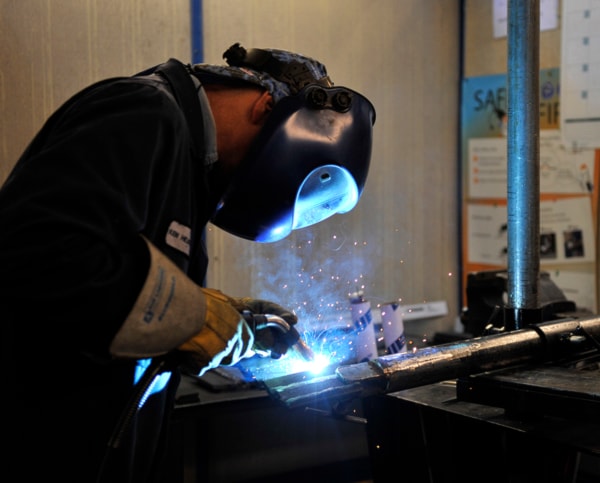As an apprenticeship welding instructor at Red Deer College, Ken Heather is literally helping fill the gaps of Alberta’s labour needs.
The province predicts a shortage of 114,000 skilled workers by 2021 and the demand for tradespeople is likely to get tighter as many sectors will need to double the workforce to compensate for the gap left by retiring baby boomers and to fill the needs of new projects. This also doesn’t include the trickle down effect of growth on the wider economy — like the need for new homes and offices.
“It’s going to be the type of thing that with the age demographics and the demand, we are going to be short on workers,” said Heather, who has been an instructor at RDC for 15 years.
“If we don’t start to promote and get young people attracted to a trades careers we are going to be in tough shape.”
High in demand are steamfitters, pipefitters, welders, heavy duty mechanics, electricians and many trades that have to do with oil and gas, and because these trades are in demand, Heather says there is a “spin-off effect” making other trades, such as carpentry and plumping, also in demand.
“We are starting to see small increases in the numbers. Industry asked us to take more students in heavy equipment and in welding,” said Patricia Rokosh, Dean of Trades and Manufacturing Technologies at RDC, who is currently writing a master’s thesis on the integration of sustainability training in the construction trades.
“So I think we are starting to see the economy move up again, and certainly, some of the key indicators for the Alberta economy are in the welding, heavy equipment and electrician trades.”
But Dan Godwin, Career Technology Studies teacher at Hunting Hills High School, says there is already a shortage of skilled tradespeople.
“You’ll see a lot of labourers, unskilled tradespeople at the job because the money is good but they don’t have the credentials and usually they’re the first ones to be laid off,” he said.
“Finding a crew that has all tradespeople is pretty unlikely.”
The health of the trades has an equal impact on standard of living, Heather said.
“People don’t really think about it very often but if it wasn’t for the trades you don’t have a desk, car, a building so they all tie back to making society work.
“And if we don’t have a raw base of people being able to build and fix, then our standard of living drops so we have to convince young people that this is a very viable option of employment.”
Godwin admitted that there is a stereotype of students who do not pursue “academic courses.”
“But when you look at the trades and what they are being paid compared to other jobs, they are well-respected,” he said.
In the 70s, Heather realized that “doors would open” if he could find employment he could do with his hands, which also appealed to his problem-solving skills.
The day after he graduated high school, he went to work as an apprentice at the Northern Alberta Institute of Technology and eventually went on to obtain his journeyman ticket.
While admitting that there is a need for engineers and designers, Heather comes back to promoting the “core raw resource” of tradespeople and in doing so he mentions the Central Alberta Regional Skills Canada competition at Red Deer College and the Skills Alberta and Skills Canada competitions in Edmonton. Also as chairman of the provincial and national technical committees for the welding arm of Skills Canada, Heather says the competitions are a way to get high school and post-secondary students involved and excited about the trades.
“The whole idea of the skills movement is to promote trades and technology to students so they start to understand what other avenues are available out there,” he said.
In April, nine regional competitions in the province, including the Central Alberta Regional Skills Canada competition at Red Deer College, wrapped up. The event saw approximately 40 high school students from Central Alberta, who competed in auto service, culinary arts, electrical wiring, carpentry, cabinet making, hairstyling and welding.
“They’re a great learning experience,” said Grade 12 Ponoka Composite High School student Keane Morrow.
Last year Morrow won the provincial competition in cabinet making and received silver in the national competition. He plans to get two journeyman tickets, one in cabinet making, the other in carpentry from RDC and NAIT.
“This gives a lot of talented people good credit for the work they can do,” he said, while he chipped away at a CD box — an advance project that required him to create dovetail joints.
In May approximately 800 students competed in the Alberta qualifier, along with the national qualifier in 43 trades ranging from brick masonry and baking, to animation, carpentry and robotics.
“It’s one of those things where a young person, even in Grade 10, can get exposure to a trade. They get an opportunity to see a new concept,” Heather said.
Meanwhile, there are 16 different trades offered at Red Deer College’s apprenticeship program, which Heather hopes can be expanded to meet Alberta’s needs.
“As the demand comes along we need to get really good at making space,” he said.
jjones@www.reddeeradvocate.com
